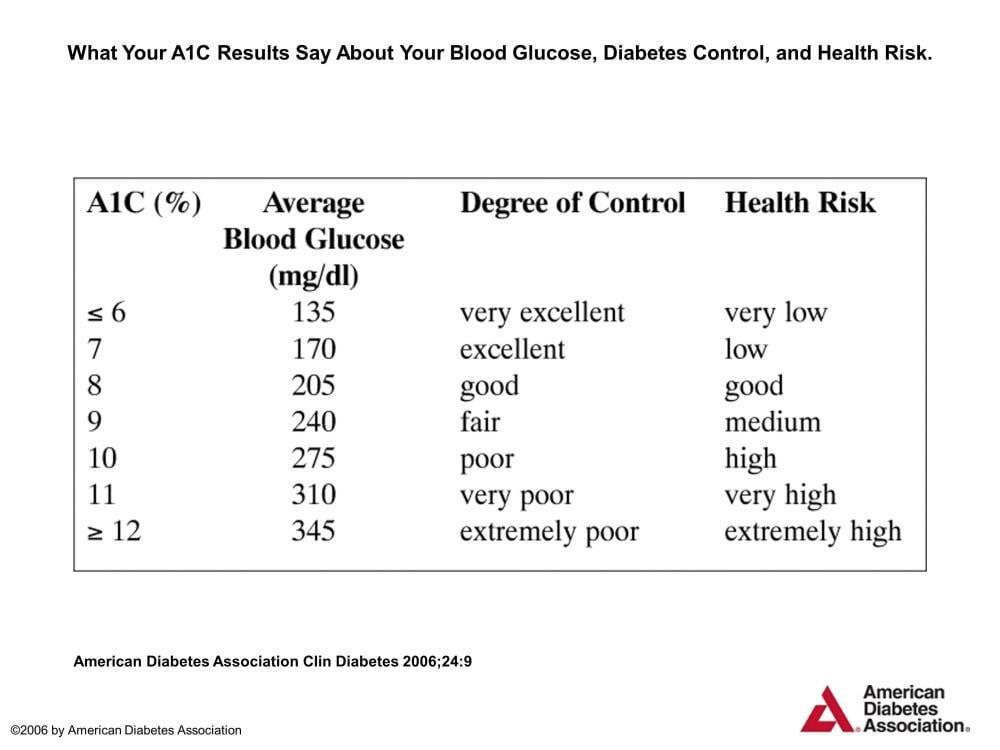A1c- Hemoglobin (Hgb)

The A1c test works by measuring the hemoglobin A1c level. Hemoglobin is stored in the red blood cells. When glucose levels are high, the sugar starts to combine with the hemoglobin. It takes the body 8 to 12 weeks to bring hemoglobin A1c levels back to normal. Therefore, if hemoglobin A1c levels are high, that means that there has been a high level of glucose in the blood over the last 2 to 3 months.
Hemoglobin A1c Mastery: Your Comprehensive Guide
The A1c test works by measuring the hemoglobin A1c level. Hemoglobin is stored in the red blood cells, and changes in red blood cells or hemoglobin, such as those seen in sickle cell anemia, can affect the accuracy of A1c test results. When glucose levels are high, the sugar starts to combine with the hemoglobin. It takes the body 8 to 12 weeks to bring hemoglobin A1c levels back to normal. Therefore, if hemoglobin A1c levels are high, that means that there has been a high level of glucose in the blood over the last 2 to 3 months. However, it is important to note that certain conditions, such as kidney failure or liver disease, can also affect A1c test results, including the type of hemoglobin you have, such as hemoglobin A. It is important to consult with a healthcare professional for accurate interpretation of A1c results.
A1c testing involves drawing blood and determining the average blood sugar level over the previous two to three months. HbA1c, glycated hemoglobin test, and glycosylated hemoglobin test are additional names for the test.

In the body, hemoglobin, a protein found in red blood cells that carries oxygen, can bind to glucose (sugar) in the bloodstream to generate HbA1c. Greater levels correspond to higher average blood sugar levels and vice versa. The amount of HbA1c generated reflects the average blood sugar level throughout time.
The A1c test is crucial for tracking diabetes, prediabetes, and glucose control in people who have already been given a diabetes diagnosis. In contrast to a single glucose reading, the test offers a thorough analysis of a person's typical blood sugar levels over an extended period of time, which is more indicative of overall glucose control. This test, along with other diabetes tests, is an important tool for health care providers in diagnosing and monitoring diabetes and prediabetes.
A1c levels below 5.7% are considered normal, whereas those of 6.5% or more is indicative of diabetes. Between 5.7% and 6.4% on the A1c scale implies prediabetes. A1c levels should be regularly checked to help people with diabetes identify and address any problems with their glucose control, modify their treatment plan as necessary, and avoid the long-term effects of uncontrolled diabetes and the risk of diabetes complications. Another important factor to consider is the time in range, or the amount of time your blood sugar levels are in a recommended target range. A typical target range is between 70 and 180 mg/dL, with a recommended TIR above 70% (about 17 hours of a 24-hour day). The NIH's National Institute of Diabetes and Digestive and Kidney Diseases (NIDDK) provides valuable resources and information for managing A1c levels and overall diabetes care.
Hemoglobin A1c Test: Everything You Need to Know
Did you know that everything you eat on a daily basis will eventually turn into glucose in the body? Whether you eat lettuce, a big steak, or some chocolate, the human body turns these foods into glucose in the bloodstream.
You can think of glucose as the fuel for humans. It's necessary for healthy living, but it shouldn't be too much, as high glucose levels can cause problems. For example, diabetes is one of the most common health problems associated with high blood sugar levels.
What is A1c and the A1c Test?
A1c is also known as glycated hemoglobin. Some red blood cells have hemoglobin with glucose attached to it. This forms A1c and its quantity is expressed as a percentage.
A1c is important because it can show you a snapshot of your glucose levels in the last 3 months (the approximate lifespan of red blood cells). Measuring the A1c will let you know if there have been major spikes in blood glucose levels in your bloodstream lately. The A1c test, also known as the hemoglobin A1C or HbA1c test, is a simple blood test that can be done easily using just a single blood sample at a doctor's office or clinic.
Who Should Do the A1c Test?
Everyone should use the A1c test kit at least twice a year, especially those who consume a lot of processed sugar every day. The American Diabetes Association recommends getting the A1c test every 1-2 years, or as often as your doctor recommends, if you have diabetes risk factors such as being over 45 years old, having had gestational diabetes, or having an initial A1c test result indicating prediabetes or diabetes mellitus. The test can also be used to monitor the glucose levels of those who already have diabetes and see if treatment goals are being met.
What Are the Normal Levels of A1c?
As mentioned earlier, A1c is expressed as a percentage. If its levels get too high, health complications might appear. Ideally, the A1c should be maintained under 6%–7%, but remember that this number fluctuates depending on your diet and the moment of the day.
Here is a basic chart on normal A1c levels and the average 3-month glucose levels they represent:
- 5% A1c correlates with an average glucose level of 97 mg/dL
- 6% A1c correlates with an average glucose level of 126 mg/dL
- 7% A1c correlates with an average glucose level of 154mg/dL
- 8% A1c correlates with an average glucose level of 183mg/dL
- 9% A1c correlates with an average glucose level of 212mg/dL
Remember that the A1c measures the glucose levels over the last 3 months. Blood sugar levels should remain relatively low and steady if you want to prevent the risk of developing diabetes in the future.
If you get a high A1c reading, it means that your glucose levels have been consistently high in the past three months. This test is different from a standard glucose test, where the doctor pricks your finger for a drop of blood to measure your current glucose levels.
Based on the results you get from an A1c test, your doctor can determine if you have healthy glucose levels or you're about to develop diabetes in the future if you don't change your eating habits. For example:
- A1c below 5.7% is non-diabetes
- A1c between 5.7% and 6.4% is pre-diabetes
- A1c over 6.4% usually means that you have diabetes type 1 or 2
What Are the Complications That Can Arise from a High A1c Reading?
As you probably already know, diabetes is a dangerous disease with multiple complications. You will need a special diet for the rest of your life and you are exposed to different health risks. Testing your A1c levels and making appropriate lifestyle changes can prevent diabetes from deteriorating your health.
It also means that you can prevent additional health complications that are usually associated with high A1c values. For example, you can avoid having to live with high blood pressure and blurry vision. Monitoring your A1c levels can also prevent stroke, nerve damage, cardiovascular problems, and heart failure.
That's why it's important to do the A1c blood test a few times per year. The test is affordable, it can be bought online, and you can get the results back in just a few days.
Is the A1c Test Kit Enough to Confirm a Diabetes Diagnosis?
In most cases, yes. However, there are other glucose tests out there that can help doctors give an even more accurate diagnosis. For example, fasting insulin test looks at the level of insulin in your body.
Once glucose gets into the bloodstream, the pancreas is instructed to produce insulin. This substance unlocks the body cells to absorb the glucose in the bloodstream. This gives you energy. When your body secretes too little insulin, you can have a high glucose level in the blood, which might lead to diabetes. It is important to regularly monitor your blood glucose levels and ensure they are within a healthy range, especially for those at risk for heart disease. The A1c test is a valuable tool for confirming a diabetes diagnosis and helping individuals maintain a healthy blood sugar level.
When too much insulin is secreted, this can lead to hypoglycemia, a condition in which you have too little glucose in the bloodstream. Maintaining a good balance between glucose and insulin is key. The fasting insulin blood test checks that for you. Some people with insulin resistance also have high insulin.
If you want to take a broader look at your health, you can do that with the Comprehensive Metabolic Panel. This panel of tests can check the level of glucose in your body as well as other substances and proteins that might contribute to poor health.
Some of the substances checked by the CMP include electrolytes, calcium, protein, creatinine, and others.
Another glucose test is the two-hour glucose tolerance test. This checks how well your body processes glucose and how quickly. In healthy individuals, insulin levels will rise when glucose is detected in the bloodstream. Once the blood sugar gets into the cells, the insulin levels drop, and everything comes back to normal.
The test is done by giving patients a sweet drink. The doctor monitors how quickly the body breaks down the glucose. The test usually takes two hours and if it takes a long time for the glucose levels to get back to normal, the patient in question might be predisposed to diabetes.
How Is the A1c Blood Test Performed?
Glucose levels can be easily determined using a single blood sample. You visit websites such as DiscountedLabs to order your A1c hemoglobin test at an affordable price. Once your order is confirmed, you will be emailed a form that you should print.
Take this form with you to the nearest lab or clinic to draw a blood sample. Once a blood sample has been taken, it will be collected into a test tube or vial and analyzed in a few business days. You can also opt for an at-home finger prick test that some companies sell, but a blood draw by professionals is the preferred method for the hemoglobin A1C test. After the blood is drawn, a lab will determine the test results and share that information with doctors and patients. You will get your results by mail and you can compare the A1c levels against reference values such as the ones mentioned in this article.
You can also go to your primary healthcare provider to help you interpret the results. The benefits of ordering the A1c test online are multiple. You receive your results quickly, the entire process is private, and you avoid the middleman, who in this case is your doctor.
Order Your A1c Test Today!
Remember that knowing your glucose level right now might not be enough. It's best to also take a look at it in the past months and see how your body is processing glucose. The A1c blood test can do exactly that - it gives you a complete snapshot of your glucose levels for the last 90 days. You could also go for an A1c test kit, but these are not as accurate as a direct-to-consumer A1c blood test.
This can be very useful to determine if you have stable glucose levels or you're about to get diabetes soon. Order your A1c test today and find out!
HOW DOES DISCOUNTEDLABS.COM WORK?
-
Go to the "Find a Location" page to find the closest lab location. No need to make an appointment since walk-ins are welcomed. Once you have identified your closest location, go to step 2.
-
Go to "Choose a Test" and add your selection (s) in the shopping cart. If you prefer to save money on bundled tests, we have created "Lab Test Panels" that can help you decide what to order.
-
If you have a discount coupon code, add it to your cart.
-
A $8 lab processing fee will be added to your total.
-
Pay using a credit card.
-
You will receive an order confirmation and instructions email on how to download your lab request.
-
Print lab request form that you downloaded.
-
Take that form to the closest location. Get your blood drawn.
-
You will receive an email when the results are ready for you to download.
Note: You cannot place an order under someone else's profile. The profile person's name will appear on the lab order form.If you have further questions, please email [email protected].



